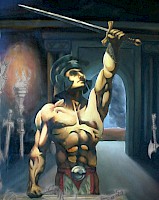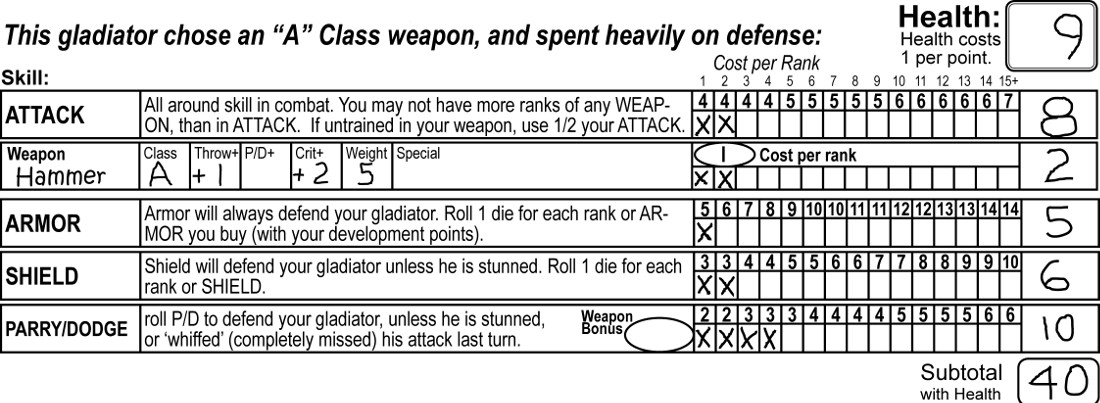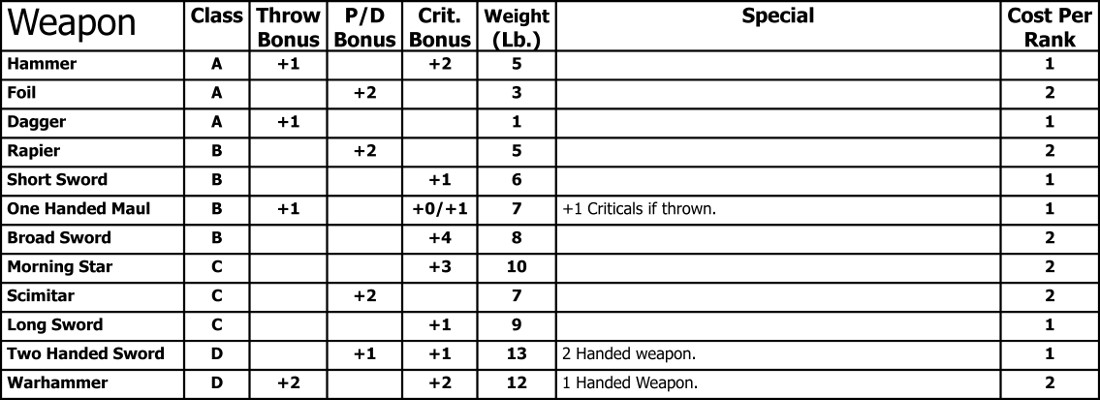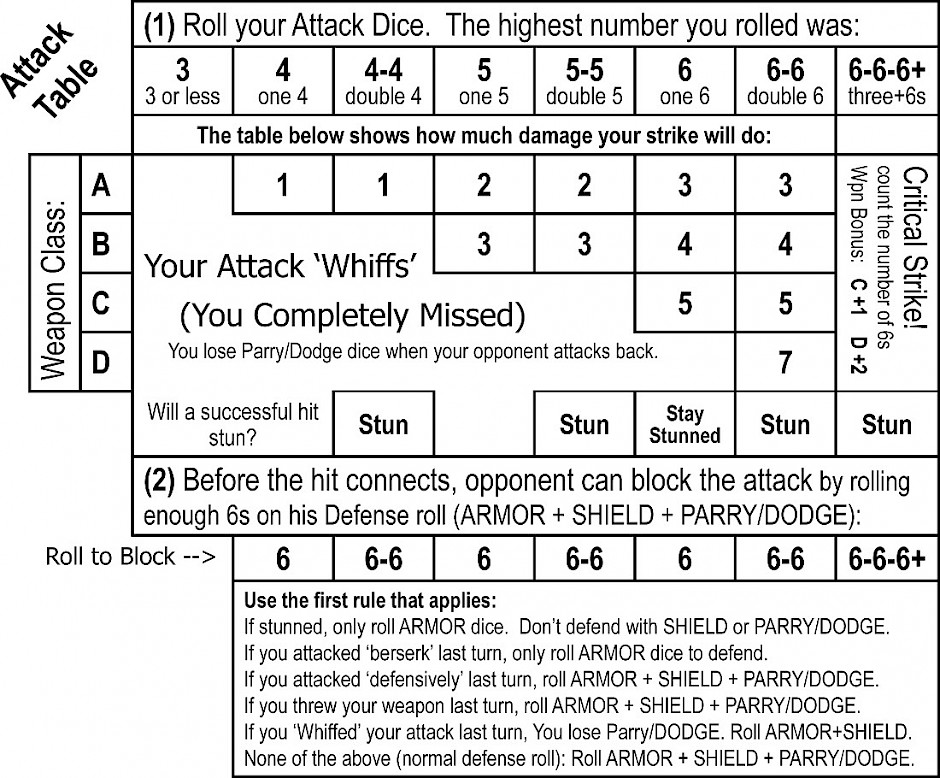Creating and Training Your Gladiator

Gladiators Battle System Official Rules - Creating and Training Your Gladiator
Object of the Game
Gladiators is a game of gladiatorial combat. Each player creates and manages one or more gladiators, challenging other players in battle. Each victory brings you closer to your ultimate goal, to become Mars, God of War.
The best way to learn Gladiators is to jump right in and play. So, please get yourself a blank ‘Gladiator Personality Sheet’ and a pencil and read on. Here's how to play...
Creating a Gladiator
The Gladiator Personality Sheet
Each gladiator is represented and kept track of by a Gladiator Personality Sheet. You will need a new gladiator personality sheet for each new gladiator that you create.
Print yourself a Gladiator Personality Sheet now. Use the sheet to create a new gladiator.
Name of Gladiator
Invent an appropriate name for your gladiator and write it in the space provided, or you can name him or her later, after you have chosen a weapon.
Player Name
Write your name here. As the addiction for battle takes hold of you, you will find that you have several gladiators under your command. Your name will assure that you can keep track of which gladiators belong to you.
Date Created
If your gladiator lives to become a legend you will be glad to know the date he was created.
You now have a rookie gladiator eager to train, let the training begin. Read on.…
Training your Gladiator
Skills
Everything that your gladiator may attempt to do while in battle will require one of the several skills that are available to him. While your gladiator will get some skills automatically (for free) when created, most require that your gladiator receive training first. Look on your Gladiator Personality sheet and you will see that your gladiator already has 2 ranks of INITIATIVE and 2 ranks of RETRIEVE WEAPON which he gets for free (they have a cost of 0). The other skills will require training.
Ranks of skill
All skills that a gladiator may possess are measured in ranks. The more ranks of a skill that a gladiator has, the more adept she is at the skill. When your gladiator attempts to use a skill in battle, you will roll one die for each rank of the skill that your gladiator has.
To train in a new skill, or to improving an existing one, will require you to spend your gladiator's Development Points.
Start with 40 Development Points
Development points are used to purchase skills for your gladiator. Each new gladiator begins with 40 development points. Spend the development points to purchase skills for your gladiator. After each battle your gladiator will receive additional development points to be spent on honing existing skills or on training in new ones. Here's how it works....
Cost of skills
Each rank of a skill has a cost. The cost is the number of development points which must be spent in order to train in a new skill or to improve an existing one.
Each skill's cost is listed with it on your Gladiators Personality Sheet. Look at your gladiator personality sheet now. The skills available to your gladiator are HEALTH, ATTACK, WEAPON skills, ARMOR, SHIELD, PARRY/DODGE, INITIATIVE, FOCUS, HEAL, STRENGTH, RETRIEVE WEAPON and SIGNATURE MOVE. To the right of each skill on the Gladiator Personality sheet, the cost for each rank of a the skill is printed, in a row of boxes. Below this row of boxes is another row of boxes, mostly empty. This row is used to keep track of how many ranks of the skill your gladiator has. You will check one empty box for each rank of the skill that your gladiator trains in.
Example Spending Development Points for Skills

-
This player purchases two ranks of ATTACK skill, paying a total of 8 Development Points.
-
The weapon “Hammer” has a “Cost Per Rank” of 1 (see Gladiator Weapons Table). You always want the same number of ranks of WEAPON and ATTACK. Two ranks of Hammer cost a total of 2.
-
This player spent 5 Development Points on ARMOR, 6 on SHIELD and 10 on PARRY/DODGE.
-
There was 9 Development Points left over from the 40, so this player spent that 9 on HEALTH.
-
This gladiator is ready to fight.
Cost of Health
Each and every rank of HEALTH costs 1 development point. A total of 12 ranks of HEALTH will cost a total of 12 development points. A total of 17 ranks of HEALTH will cost a total of 17 development points, etc... Your gladiators HEALTH is the amount of damage that he or she can sustain in battle before being susceptible to losing consciousness.
Don’t forget to spend some of your rookie gladiator’s 40 development points on HEALTH!
Cost of Weapon Skills
Weapon skills work a bit differently. Each weapon in the Gladiators game has a cost of either 1 or 2 development points per rank. Each and every rank of the weapon has the same cost. For example, the FOIL has a cost of 2 development points per rank. If you train your gladiator with 3 ranks of FOIL skill, it will cost you a total of 6 development points. Each weapon's cost is listed with it on the Gladiators Weapons Table.
Cost Per Rank is Shown on the Gladiators Weapons Table

Three of the 46 weapons available to your gladiator.
Basic Fighting Skills Descriptions
When training your first gladiator, it is wise to limit your training to these six basic skills used for attacking your opponent and defending yourself:
-
ATTACK skill (recommended 3 or more ranks)
-
WEAPON skill (equal to your ATTACK ranks)
-
HEALTH (recommended at least 10 points)
-
Defensive skills: PARRY/DODGE and/or SHIELD and/or ARMOR.
The advanced skills: INITIATIVE, FOCUS, HEAL, STRENGTH, RETRIEVE WEAPON and SIGNATURE MOVE will be more attractive to your gladiator when she has gained experience (more Development Points) after a few battles.
ATTACK Skill
ATTACK designates an all around skill in combat, and you may not have more ranks of any WEAPON than you have in ATTACK skill.
For Example, Your rookie gladiator has 3 ranks of ATTACK. He is allowed to train for up to 3 ranks in as many different WEAPONs as he chooses, but he may not train for his fourth rank in any WEAPON until he first (or at the same time) trains for his fourth rank of ATTACK.
When you attack with a weapon, you will roll a number of dice equal to the average of your ranks of ATTACK and ranks of the WEAPON.
Dice to Roll when Attacking = ( ATTACK ranks + WEAPON ranks ) / 2
-
Round UP, if you have 0 ranks in the WEAPON.
-
Round DOWN if you have 1 or more ranks in the WEAPON.
Clearly, the best strategy is to keep your WEAPON ranks equal to your ATTACK ranks. In this case, you will be rolling a number of Attack Dice equal to your ATTACK ranks.
Fighting Without a Weapon
Sometimes your gladiator will throw or drop his weapon(s), and be forced to “Brawl” (without a weapon), or possibly even fight with a different weapon. If your gladiator is unskilled in the weapon he is using to make an attack, you will still roll a number of attack dice equal to ½ of your gladiator’s ATTACK ranks (round up).
ARMOR Skill
ARMOR is the most effective defense for your gladiator, but also the most expensive. When hit in combat by your opponent, you will roll ARMOR dice in an attempt to block the blow.
Your gladiator will always use his ARMOR skill to defend being hit.
SHIELD Skill
SHIELD is fairly effective for defense, but also fairly expensive for your gladiator to train in. When hit in combat by your opponent, you will roll SHIELD dice in an attempt to block the blow. However,
You may not use SHIELD skill if your gladiator is ‘stunned’.
PARRY/DODGE Skill
PARRY/DODGE is the least effective, but also the least expensive defensive skill your gladiator can train in. When hit in combat by your opponent, you will roll PARRY/DODGE dice in an attempt to block the blow. However:
You may not use PARRY/DODGE if your gladiator is ‘stunned’.
You may not use PARRY/DODGE if your gladiator ‘whiffed’ his attack on the previous turn.
HEALTH
Your gladiators HEALTH is the amount of damage that he can sustain in battle before losing consciousness. You can purchase HEALTH for your gladiator at a cost of 1 development for each rank of HEALTH purchased. Each time that your gladiator is wounded, he or she will lose one or more points of HEALTH.
When your gladiator's HEALTH is reduced to below zero points, he is susceptible to falling unconscious, into a coma or even death. Unless he is killed, your gladiator will recover all of his lost HEALTH before the next battle.
During the battle, keep track of the health of both gladiators on the Health Tracker. Don’t change the Health on your Gladiator Personality Sheet.
It wise to purchase at least 10 points of HEALTH when you create a new gladiator. Of course, not all gladiators are wise.
WEAPON Skills
There are dozens of weapons available for your gladiator to choose from. You’ll want to choose one or perhaps eventually two weapons to become proficient in. It is best to train so that your gladiator’s WEAPON ranks always equals her ATTACK ranks. It will cost either one or two development points to purchase each rank of a WEAPON skill. The cost is listed with each weapon on the Weapons Table.
Weapons
Your gladiator can choose any weapon he wants to use. The Gladiators Weapons Table shows all of the available weapons, along with the various factors which make each weapon unique. The Gladiators Weapons Table is included just a few pages ahead, after the brief explanation of how it works.
Weapons Recommended For Your First Gladiator:
This is a shortened weapons table, simplified for beginning players. It has the throwing weapons removed and some other weapons removed. It also serves as a good example, as we discuss Weapons in detail.

Shortened Weapons Table – Weapons Recommended for Beginners
Weapon Class
Weapon Class is the first and most important factor to consider when choosing a weapon for your gladiator. Each weapon is either attack class A, B, C or D.
A Class Weapons
A class weapons are lightweight and easy to use weapons of finesse. These weapons rarely miss (whiff), but do little damage. Class A weapons provide the best defense. Class A weapons include: Quarter Staff, Hammer, Foil, Whip, Dagger, Shurikin, War Dart, Stiletto and Cleaver.
With any A weapon, you only need to get one 4 or better to hit, when you roll your Attack Dice.
B Class Weapons
B class weapons are mid-sized weapons. They are easy to use, provide good defense and do a fair amount of damage. B weapons are: Brawling, Bo Stick, Spear, Cat O Nine Tails, Rapier, Club, Tri-Sectional Staff, One Handed Axe, Short Sword, One Handed Maul, Broad Sword, Boomerang, Razor Disk and Javelin.
To hit with a B class weapon, you will need to get one 5 or higher, when you roll your Attack Dice.
C Class Weapons
C class weapons are heavy offensive weapons. They don't hit as often, but do a lot of damage. C weapons are: 2 Handed Scythe, Pole Arm, Morning Star, Ball and Chain, Scimitar, Battle Axe, Khopesh, Long Sword, Harpoon, Battle Javelin, Combat Boomerang and Executioner's Sword.
To hit with a C class weapon, you will need to get at least one 6 when you roll your Attack Dice.
D Class Weapons
D class weapons are weapons of massive destruction. D weapons almost always whiff, but do the most damage when they hit - so much that they always stun and kill more often! D weapons are: Two Handed Sword, Two Handed Battle Axe, Thor’s Axe, War Hammer, Two Handed Maul, Widowmaker and Claymore.
To hit with a D class weapon, you will need to get at least two 6s when you roll your Attack Dice.
Gladiators Attack Table
Refer to the Gladiators Attack Table to see how a weapon's class specifically effects its performance.

Throw Bonus
Some weapons are better for throwing than others. These weapons have a Throw Bonus listed on the Weapons Table. If your gladiator throws his weapon in battle, add the weapon's Throw Bonus to the number of dice you roll on the attack (your Attack Roll).
For more details, read the rules on throwing weapons later in the How to Play Gladiators section of this rule book. Weight (15 lb. limit)
This is the weapon’s weight in Pounds. A gladiator may carry 15 lb. worth of equipment into battle, plus 3 lb. for each rank of STRENGTH she has. Armor is considered weightless because the ARMOR skill essentially teaches the ability to fight effectively while wearing it.
A shield weighs 5 lb. If your gladiator has SHIELD skill, choose a weapon of 10 pounds or less weight. If you want a heavier weapon, your gladiator also needs STRENGTH skill to fight with the extra weight.
If you are throwing your weapons(s), your weight limit will determine how much ammo you can carry into the arena. For example, Boomerangs weigh 2 pounds each. If you gladiator does not use a shield, she can bring 7 boomerangs into the battle (total of 14 lb.). If she has a shield, she may bring only 5 boomerangs (total 15 lb. Including shield).
Parry/Dodge Bonus
Add this amount to the number of dice you roll when your gladiator is using his PARRY/DODGE skill.
You will lose this bonus only if your gladiator attacked with a different weapon the last time he attacked, or if your gladiator has no weapon. Otherwise your gladiator will always get this bonus, for example at the start of the battle, or if he did something other than attack on the previous turn, or has just recovered from a stun.
Critical Damage Bonus
Add this number to the total you roll when rolling for critical damage.
For example, let's say you rolled to attack and got a 6-6-6-6 critical hit with the Broad sword (B weapon, +4 Critical Damage Bonus). Your opponent did not roll any 6s in defense, so you will roll 4 dice for critical damage you roll 2 3 4 6 for a total of 15. Before you look on the Critical Damage Table to assess the damage, add +4 (the Critical Damage Bonus for the broad sword) for a new total of 19. Looking at the Slashing Weapons Critical Damage Table, you will find that you have done 11 points of damage and stunned your opponent:
“Rib hacking blow to chest sends opponent to the ground several feet away (11 Damage and Stun).”
2 Handed Weapons
Some weapons require 2 hands. You may not use a shield with a 2 Handed weapon.
If you decide to use a two handed weapon, just cross out the SHIELD skill on your Gladiator Personality Sheet, so you don’t accidentally buy any SHIELD you won’t be able to use.
Though rarely done, your gladiator may, of course, carry both a shield and a 2 handed weapon into battle, however as soon as he attacks two handed, he must drop the shield to the ground. It may later be retrieved as if retrieving a weapon.
Must be Thrown / Can Not be Thrown
The Shurikin, War Dart, Razor Disk, Javelin, Harpoon, Battle Javelin, Combat Boomerang and Widowmaker must be thrown. They may not be used to attack conventionally.
The Whip and Cat O Nine Tails can not be thrown. However these act exactly like thrown weapons in that a normal or defensive attack can not whiff, only miss, which does not result in a loss of PARRY/DODGE when your opponent attacks on his next turn.
Cost per Rank
This is the training cost for each rank of the weapon. Some weapons cost 1 point per rank, some cost 2 per ranks. Your gladiator may not purchase more ranks of any WEAPON than he has of ATTACK skill.
Your gladiator may train in as many different weapons as you choose. Of course, you will need to spend development points for each WEAPON skill, however you only have to train in ATTACK once.
BRAWLING Weapon Skill
Brawling is skill in fighting without a weapon. Brawling works just like fighting with any other B weapon. Remember, even if you have no skill in brawling, your gladiator can still brawl (or use any weapon) with ½ of his ATTACK ranks (rounding up). This is an option to remember if your gladiator finds himself weaponless.
Weapons with Two Weapon Classes (A/B B/C C/D)
Declare if you are attacking one handed or two handed before each attack. If you attack two handed, you will have to drop your shield to the floor, if you have a shield.
Disarming your Opponent with the Whip
On your turn, you may choose to give up your attack, and attempt to disarm your opponent instead. You must declare this called shot, before you attack.
Roll half the number of dice you would roll for a normal whip attack (round down). You need to roll at least one 6, just like you are attacking with a C Class weapon.
If you ‘hit’ with at least one 6, your opponent gets a chance to block the disarm. He will defend just like defending a normal attack, however he does not use any ARMOR to block. Also he will roll 3 extra defense dice if using a 2 handed weapon.
If he does not block (by rolling an equal number of 6s as you), then he is disarmed. If he has more than one weapon type, the last weapon he attacked with is dropped to the floor.
If you do not roll at least one 6 for your disarm attempt, this counts as a ‘whiff’, and you lose you PARRY/DODGE when your opponent attacks back (even though you are using a whip).
Studded Gauntlets (weapon) can not be disarmed.
Have Fun
Tenzing Kernan